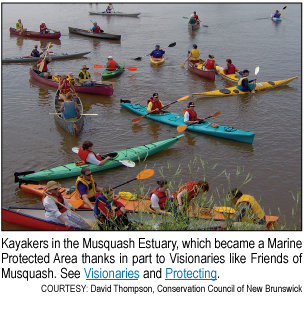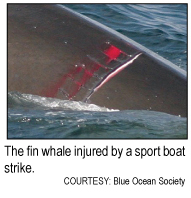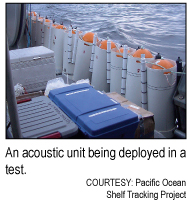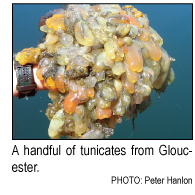
Visionaries
in the Gulf of Maine
By Susan Llewelyn Leach
For years as a young lad Roger
Berle would heed his mother’s request to take out the trash.
On Cliff Island that meant dragging the bag from under the kitchen
sink and trotting down to the shoreline to toss it in the ocean.
It’s a story he tells with
wry irony. As one of the most energetic and effective proponents
of conservation in Maine’s Casco Bay, Berle said he’s
been making up for that trash misadventure ever since.
In the
intervening years, his focus has been as much about preserving
island life as it has the natural habitat that makes that life
so appealing.
[Read
more]
Ambassador
for his species: If a whale could speak
 By
Cathy Coletti By
Cathy Coletti
“Do you know you hit a whale?!”
shouted my mother from the side of the Atlantic Queen about 20
miles (32 kilometers) offshore in the Gulf of Maine. The upswell
of anger ran through this group of about 60 whale watchers like
electricity.
It was
one of those days you hope will never happen again. Too many
circumstances had come together, too many things that are unknowable
and unplannable. The seas were calm. The sun was out. Visibility
was perfect. The cool ocean air smelled of salt. My mother was
meeting my little sister from Big Brothers Big Sisters after
about a year of trying to get a mutually agreeable date. The
three of us were out on Jeffrey’s Ledge in the Gulf of
Maine in mid July, seeing whale after whale.
[Read
more]
|
|
|
|
Ocean Tracking
Network to shed light on undersea life
By Stephen Leahy
Imagine a spotlight on the ocean
floor just off of Halifax, Nova Scotia, powerful enough to create
a tube of light 400 metres or 1,312 feet in diameter and 20 kilometres
or 12 miles out to the edge of the Scotian shelf. And imagine
what this tube of light might reveal operating continuously.
While no such spotlight exists
yet, there soon will be something akin to it. A series of up
to 212 acoustic receivers, one every 732 metres (800 yards) or
so on the ocean floor, soon will create an “acoustic curtain”
180 kilometres (112 miles) offshore of Halifax to the edge of
the continental shelf that will detect fish, seals, whales and
other marine animals tagged with tiny ultrasonic transmitters.
“We’ll
be able to detect exactly when Atlantic salmon from the Gulf
of Maine pass by on their way to Newfoundland and Labrador,”
said Ron O’Dor, a researcher at Dalhousie University in
Halifax. Sensors also will detect temperature, salinity, pressure
and current speeds, offering new insight into when animals move
and under what conditions. This could fundamentally alter the
management of fisheries. “Marine scientists have never
had continuous streams of data from the ocean floor before,”
he said.
[Read
more]
On the trail
of invasive species
By Peter J. Hanlon
Deep-sea biologists have multi-million
dollar submersible vehicles. Physical oceanographers rely on
networks of satellites and buoys. And marine invasive species
experts use spatulas and nets. Clearly the latter are not the
gear-heads of the marine research world.
Despite the lack of high-tech
equipment, the search for non-native species has an international
appeal. Organisms from literally any point on the globe can be
transported to the Gulf of Maine through the ballast of cargo
ships, the baitfish industry, the release of aquarium pets into
the wild and fouling on the bottom of recreational boats.
[Read
more]
|